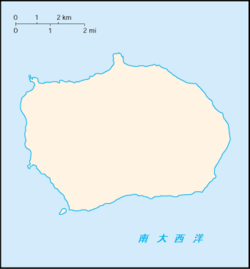Bouvet Island
|
|
Bouvet Island (Norwegian: Bouvet°ya) is an uninhabited sub-antarctic volcanic island in the South Atlantic Ocean, south-southwest of the Cape of Good Hope (South Africa).
| Contents |
Geography
Bouvet Island is located at Template:Coor dm. It is 58.5 km² (22.6 square miles) large and almost entirely covered by glaciers. It has no ports or harbors, only offshore anchorages, and is difficult to approach. The glaciers form a thick ice layer falling in high cliffs into the sea or onto the black beaches of volcanic sand. The 29.6 km (18.4 miles) of coastline are often surrounded by an ice pack. The highest point on the island is called Olavtoppen, whose peak is 780 m (2,600 ft) above sea level.
Bouvet Island is a candidate for the most remote island in the world, along with other small insular islands such as Tristan da Cunha, Easter Island and the Pitcairn Islands. The nearest land is Queen Maud Land, Antarctica, over 1,600 km (1,000 miles) away to the south, which is itself uninhabited.
History
Bouvet Island was discovered on January 1, 1739 by Jean-Baptiste Charles Bouvet de Lozier, who commanded the French ships Aigle and Marie. However, the island's position was not accurately fixed and Bouvet did not circumnavigate his discovery, so it remained unclear whether it was an island or part of a continent.
The island was not sighted again until 1808, when it was spotted by one Lindsay, who was the captain of a whaler. Though he didn't land, he was the first to correctly fix the island's position. The first successful landfall dates to 1822, when a captain Morrell landed, hunting for seals. In 1825, one captain Norris landed on the island, named it Liverpool Island and claimed it for the British Crown. In 1898, the German Valdivia expedition of Carl Chun visited the island, but didn't land. The first extended stay on the island was in 1927, when a Norwegian crew stayed for about a month; this is the basis for the territorial claim by Norway, who have named the island Bouvet°ya (Bouvet Island in Norwegian). The UK waived its claim in favor of Norway the following year.
In 1971, Bouvet Island and the adjacent territorial waters were designated a nature reserve. The island remains uninhabited, although an automated weather station was set up there in 1977 by the Norwegians.
On September 22 1979, a satellite recorded a flash of light (which was later interpreted as having been caused by a nuclear bomb explosion or natural event such as a meteor) in a stretch of the southern Indian Ocean between Bouvet Island and Prince Edward Islands. This detonation, since dubbed the Vela Incident, scattered radioactive debris over a wide area (it was detected by scientists in the Australian Antarctic Territory). No country has ever admitted responsibility for the test, though suspects range from South Africa, Israel or Taiwan.
Despite being uninhabited, Bouvet Island has the Internet country code top-level domain (ccTLD) .no (.bv is allocated but not used (http://www.norid.no/domenenavnbaser/bv-sj.html)). A handful of amateur radio expeditions have gone to this remote location. The callsign used here begins with 3Y. In case you need to reset your watch on arrival, Bouvet Island falls within the UTC Z time zone. For the more precise Atlantic/St_Helena is the zone used in the time zone database.
Bouvet in Literature
Bouvet, redundantly called "Bouvet°ya Island," was the setting of the 2004 movie Alien vs. Predator. It also figured prominently in the book, "A Grue Of Ice".
See also
External link
- Information on Bouvet Island (http://www.btinternet.com/~sa_sa/bouvetoya/bouvetoya.html)
- Bouvet Island - Bouvet°ya (http://www.70south.com/resources/islands/bouvet)ca:Bouvet
da:Bouvet°en de:Bouvetinsel fr:╬le Bouvet it:Isola Bouvet nl:Bouvet ja:ブーベ島 no:Bouvet°ya pl:Wyspa Bouveta sl:Otok Bouvet sv:Bouvet÷n


